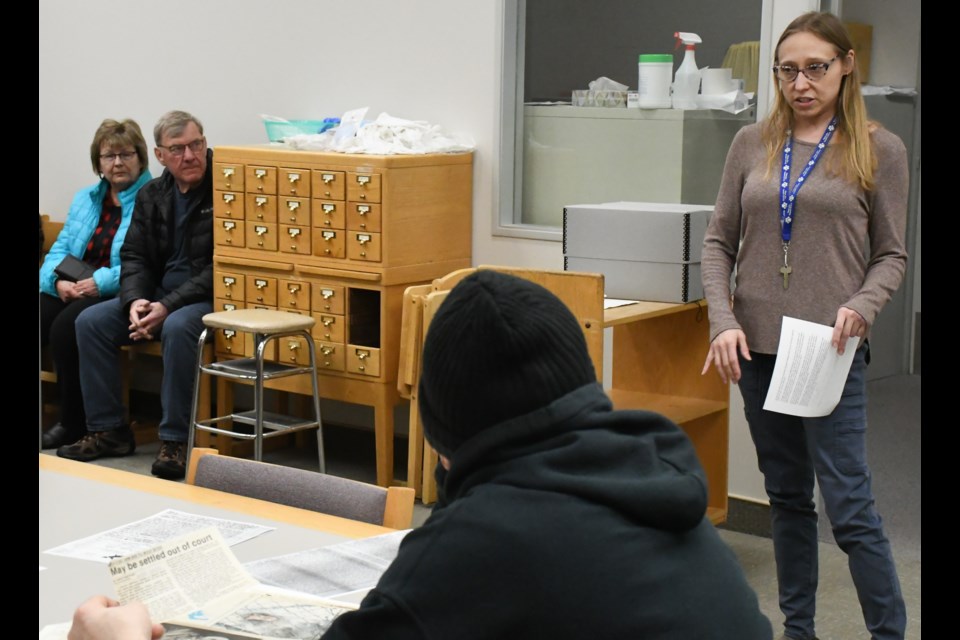The Wild Animal Park was a beloved attraction for nearly 70 years that was eventually consigned to the pages of history — a history that the Moose Jaw Public Library recently showcased.
Roughly 20 people visited the archives room on Feb. 8 to learn more about the park and flip through many pictures and articles the library department had accumulated over the decades.
The open house was part of activities the library held to celebrate provincial archives week from Feb. 4-10.
Wearing blue disposable gloves, Carolyn and Jan Swanson flipped through dozens of old pictures the park photographed decades ago. They attended the open house because they are long-time residents, are interested in the archives and appreciate the community’s history.
The couple usually visited the Wild Animal Park twice a year because their kids’ school held activities there; they also visited for family picnics. Meanwhile, when the Swansons were children, they attended the annual powwows and rodeos.
“… So, (a) lot of good memories, actually, and it’s too bad (the park closed),” said Mrs. Swanson.
Mr. Swanson’s favourite part was the animals — foxes and coyotes — on the river’s south side. He noted that larger animals, such as bison and elk, came along after the park erected perimeter fencing where powwows and rodeos used to be.
It was a sad day when the province closed the park, although it did a better job of running the venue than its previous owners, added Mrs. Swanson. Furthermore, the Wild Animal Park was the only zoo in Saskatchewan at that time and was a major tourist attraction; there is now one less fun place to visit with children.
Besides pictures, there were also many newspaper clippings, including two stories about wolf attacks.
While most people remember a 10-year-old boy losing his arm in 1989 after he jumped the fence and poked the animals with a stick, there was another attack in 1986. This one saw three wolves attack an eight-year-old boy after he grabbed grass to feed them; a visiting nurse saved the boy’s life and he kept his arm.
According to archival material, the Moose Jaw Wild Animal Park Society formed in 1928 after real estate agent Frank McRitchie promoted the subject for two years prior. Landowner John R. Green allowed the society to use several hundred acres of his property along the river.
While festivities began on May 24, 1929, the park officially opened its doors a day later, and since it had not received an official name, the society called it Chief Sitting Bull Park. That name remained for some time before the society changed it to the Moose Jaw Wild Animal Park.
The group imported many native and non-native animals, including bison, bears, wolves and various fowl, and before long, purchased more exotic animals like lions and a hippo. However, the latter was injured during transportation and had to be euthanized en route.
The park also imported turkeys and pheasants, and, according to the archival material, the birds’ breeding programs became responsible for the species’ current populations in Saskatchewan.
Stephanie Jeanes, an archival assistant, said the archives have many letters about purchasing turkeys between the park and a supplier in Mississippi, including one document with a feather attached.
“There was lots of wheeling and dealing with (purchasing) those turkeys,” she joked.
While the files are irreplaceable since they are old and original, they are also amazing and invaluable to have, while it’s also great to have a venue in which to store them, said Jeanes. She commended former library employee Leith Knight for creating the archives to preserve the community’s history.
A volunteer group operated the park from 1929 until 1958, but by the ’50s, city officials believed the group was too small to handle operations and asked other service groups to become involved, the report continued.
The Lions Club took over in 1958, while the provincial government took over around 1965 and operated it as a regional park until 1987 before privatizing it.
Several private owners operated the park until 1994 before Dr. You Seuk Sung took over, the records show. However, he was unable to acquire liability insurance and the province closed the park in September 1995.
“Litigation followed over ownership and the length of time that Dr. Sung had been allowed to pursue insurance,” one report added.
In 2019, city council renamed the site to Tatawaw Park, which in Cree means “There is room for everyone; welcome.”




